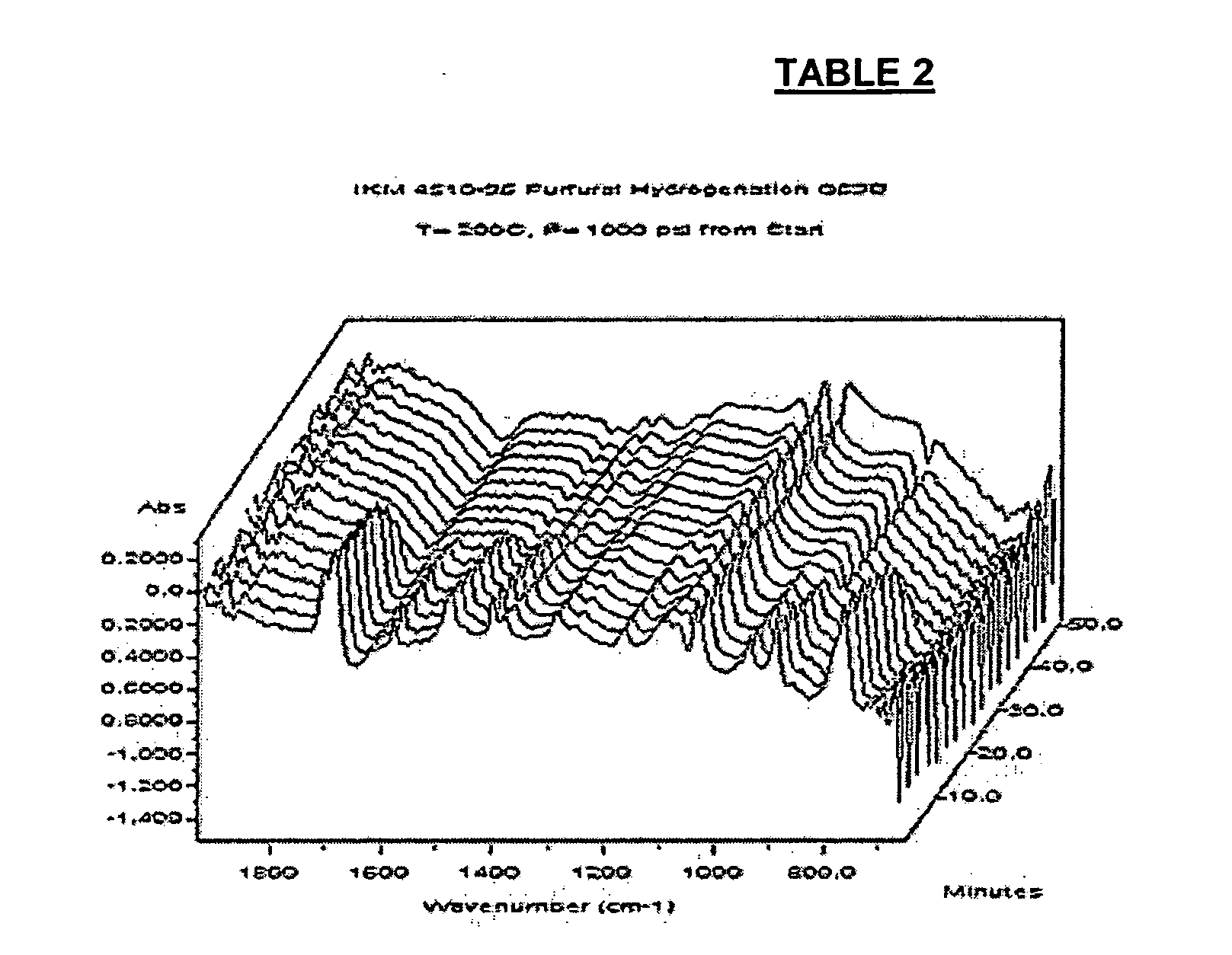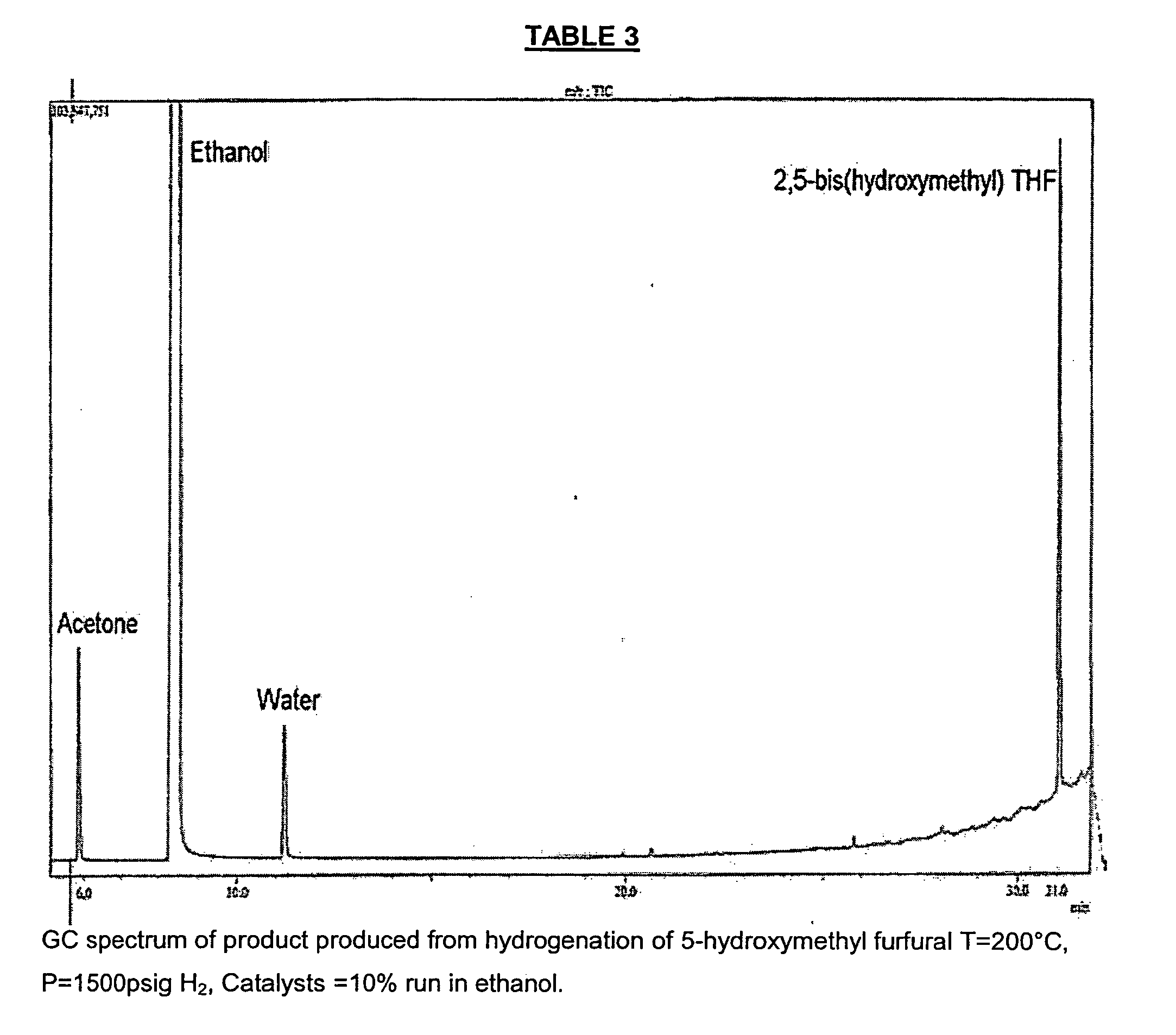Conversion of 2,5-(hydroxymethyl)furaldehyde to industrial derivatives, purification of the derivatives, and industrial uses therefor
a technology of hydroxymethyl furaldehyde and industrial derivatives, which is applied in the field of conversion of 2, 5(hydroxymethyl) furaldehyde to industrial derivatives, purification of the derivatives, and industrial uses therefor. it can solve the problems of high cost, inability to use bf/sub>3/sub>et/sub>o as a catalyst, and high cost of hexos
- Summary
- Abstract
- Description
- Claims
- Application Information
AI Technical Summary
Benefits of technology
Problems solved by technology
Method used
Image
Examples
example 1
[0039] PREPARATION OF THF-DIOL FROM HMF REACTION MIXTURE: A reaction mixture containing 54% by weight (wt %) HMF (20.2 g) and anhydrous denatured ethanol (300 ml) was charged into a 1 liter reaction vessel. 3.0 g of G-69B catalyst, obtained from Sud-Chemie, Louisville, Ky., was added to the vessel. (G-69B is a powdered catalyst containing nominally 62% Nickel on Kieselguhr, with a Zirconium promoter, and has an average particle size of 10-14 microns. The manufacturer specifies that it is suitable for hydrogenation of terpene compounds.) The vessel was purged with hydrogen (4×500 pounds per square inch (psi)) with stirring (1000 revolutions per minute (rpm)). The vessel was then pressurized to 1500 psi and heated to 200° C. with continual stirring. After 1 hour, the reaction was allowed to cool to 40° C., and the catalyst removed by vacuum filtration. The solvent was removed by rotary evaporation to provide a brown oil (19.54 g). UV analysis (λ=284 nm) did not show the presence of HM...
example 2
[0040] PREPARATION OF THF-DIOL FROM HMF: A mixture containing 98% HMF (Aldrich, 5 g) and anhydrous denatured ethanol (300 ml) was placed in a 1 liter reaction vessel. To this mixture was added a heterogenous catalyst 10% G-69B (from Sud-Chemie Inc., Louisville, Ky.), and the reaction was allowed to proceed for 12 hours at 200° C. and 1500 psi. Mass-spectrum: m / z=124 showed that HMF was completely hydrogenated to THF-diol.
[0041] Experiments were also conducted to determine the most desirable reaction conditions. Some experiments used 2-furaldehyde as a starting material, and hydrogenated the aldehyde group to an alcohol. The reaction was performed under spectroscopic observation, monitoring the loss of the carbonyl group, which represented the point of conversion to the saturated alcohol. 2-furaldehyde was maintained at 200° C. and at 1000 pounds per square inch (psi) hydrogen with varying catalyst loading levels and monitored by infrared spectroscopic analysis (IR). Tables 1 and 2 ...
example 3
[0045] PREPARATION OF THF-DIOL FROM HMF: An HMF containing distillate (20.8 g, 96% HMF) was placed in ethanol (300 ml), and G-69B catalyst (10%) was added. Hydrogenation was performed at 200° C. and 1500 psi for 1 hour. GC / MS data revealed complete conversion of HMF to THF-diol.
PUM
| Property | Measurement | Unit |
|---|---|---|
| Temperature | aaaaa | aaaaa |
| Temperature | aaaaa | aaaaa |
| Temperature | aaaaa | aaaaa |
Abstract
Description
Claims
Application Information
 Login to View More
Login to View More - R&D
- Intellectual Property
- Life Sciences
- Materials
- Tech Scout
- Unparalleled Data Quality
- Higher Quality Content
- 60% Fewer Hallucinations
Browse by: Latest US Patents, China's latest patents, Technical Efficacy Thesaurus, Application Domain, Technology Topic, Popular Technical Reports.
© 2025 PatSnap. All rights reserved.Legal|Privacy policy|Modern Slavery Act Transparency Statement|Sitemap|About US| Contact US: help@patsnap.com



